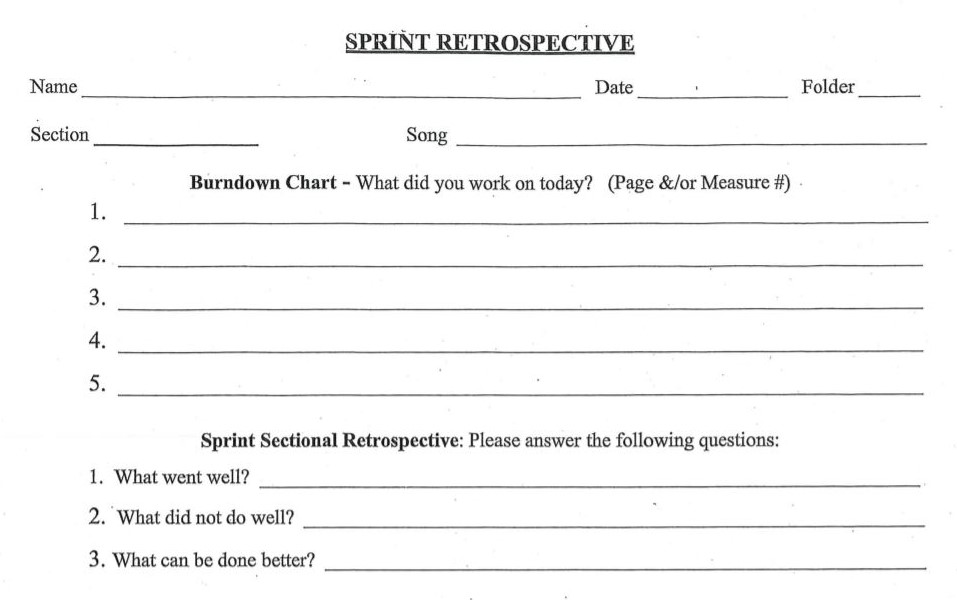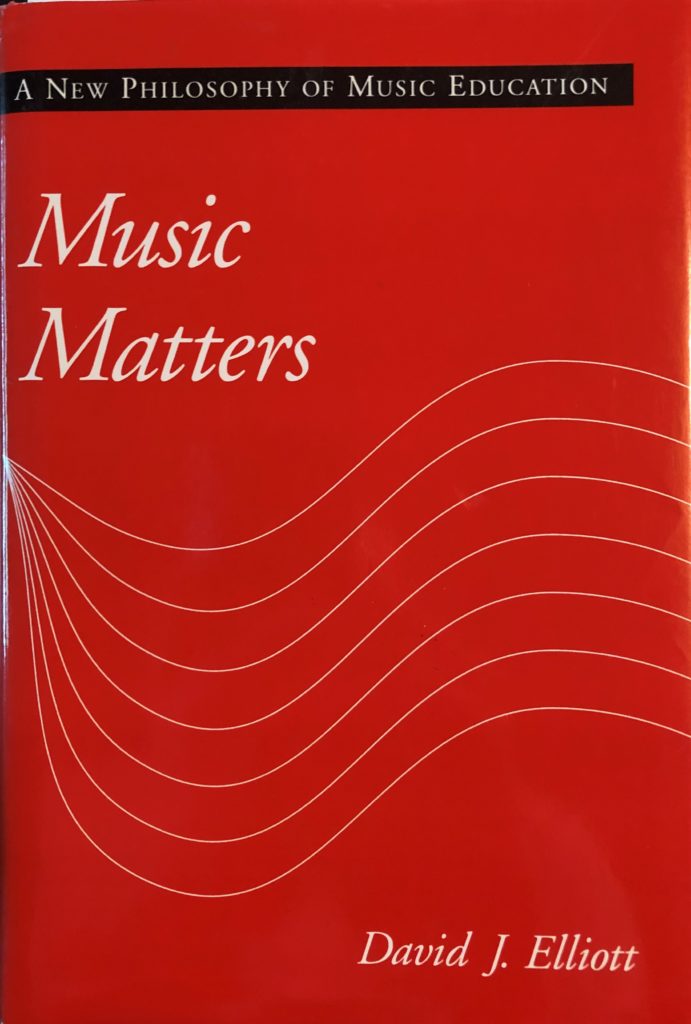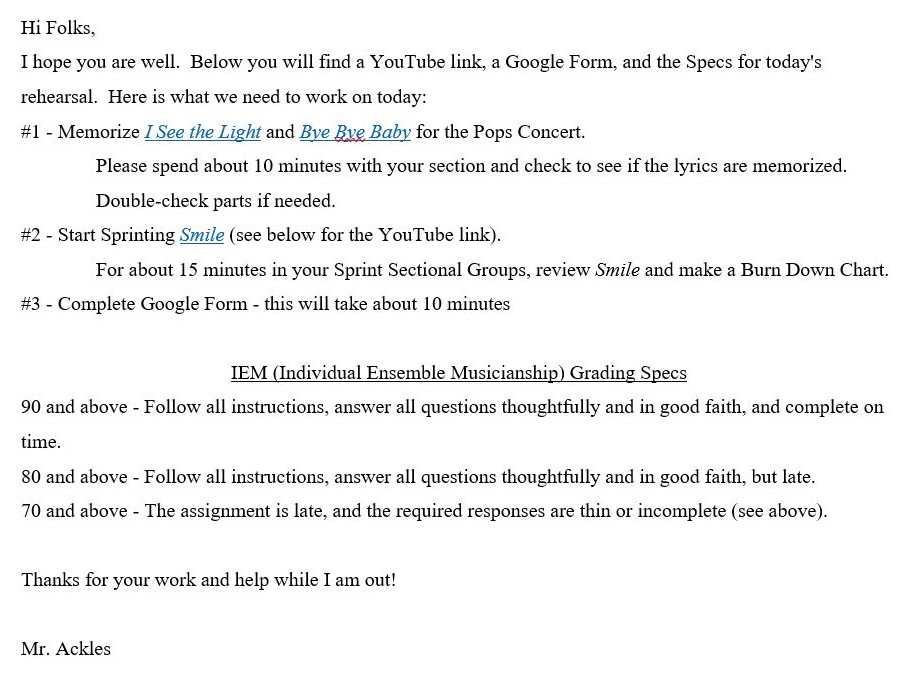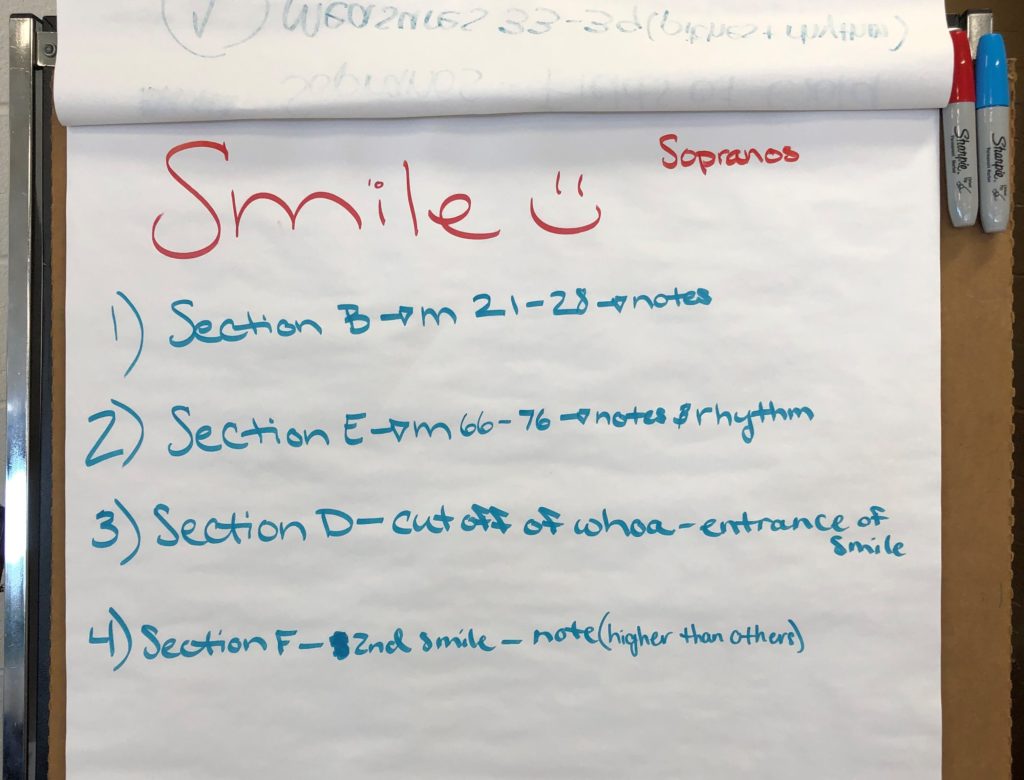
While I was out sick recently for a week with COVID, one of my lesson plans for the Select Choir consisted of having the students break into their Sectional Sprint Groups and check and memorize their music for their upcoming Pops Concert the following week. At the end of each student-run Sectional Sprint rehearsal, I always ask my students to reflect on the following Sprint Retrospective.
We can pull out a lot of great information about the choirs’ current abilities and our effectiveness through periodically asking our students these three questions. Here is a response from Jessie, who was a part of the Select Choir Soprano Sprint Group.
What went well?
Jessie’s observation – “We were able to sing most of the song correctly and were able to identify what needs to be fixed next time we sing it.” My assessment – The soprano section has the ability to work independently, assess their performance, and identify areas for future improvement.
What did not go well?
Jessie’s observation – “We could use more dynamics when singing the song, especially on the half and whole notes we are holding out.” My assessment – Not only did they determine that their dynamics were lacking, but they identified the specific issue of not holding out note values.
What could be done better next time?
Jessie’s observation – “Next time we can try to incorporate dynamics and emotion into the song, crescendo-ing, and decrescendo-ing when needed.” My assessment – I will now reinforce and share the soprano’s attention to dynamics and emotions with the rest of the choir and apply this concept to other songs we will be singing for the Pops Concert.
Promoting Agency with Sprint Retrospectives
Using Sprint Retrospectives in the classroom is beneficial because I can quickly and easily assess the students’ understanding, apply the Specification Grading, and use this new information to shape future learning. I believe teaching our students to become aware of, reflect upon, identify, and act on new understandings is at the core of teaching lifelong musical skills and a love for learning.
Encouraging and promoting awareness during a rehearsal will develop self-confidence, self-regulation, and outstanding independent student musicians. As musicians and educators, we have learned to ask ourselves these Sprint Retrospective questions, but have we taught our students to do the same?
When I look back at my K – 12 public music education and growing up participating in many church choirs, I would say no. Usually, after a concert or worship service, the director would give us an assessment of our performance, the director would tell us how we could improve, and the director would implement their observations and ideas.
Promoting Agency within the Lesson Structure
Usually, our students are not taught how to become musically self-sufficient and independent under the traditional director-centered paradigm. This time-tested paradigm effectively produces outstanding performances, but it inherently cannot nor will not promote choral independence and agency. The problem is not with the traditional lesson or rehearsal structure but rather in the presentation and implementation of music learning and agency skills. I was trained in the classic Seven-Step lesson plan design and continue to use the following basic elements with great success.
My warm-ups are my (1) Anticipatory Set and hook for the day. I always write on the whiteboard the rehearsal plan and (2) State the Objective(s) right after warm-ups. Through my lesson preparation and score study, my rehearsal activities and sequence present the desired (3) Instructional Input. As the choir works through the lesson, I (4) Model learning strategies and skills that reinforce and point to the stated objectives. Through (5) Guided Practice, I continually (6) Check for Understanding and modify instruction as needed. Throughout the rehearsal, I integrate the Agile Development Instructional Framework (ADIF), which gives the students opportunities to assess, plan, and (7) Practice independently. My lesson (8) Closure is presented periodically throughout the rehearsal and points back to the lesson objective and purpose.
The Instructional Theory into Practice (ITIP) developed by Madeline Hunter offers an excellent structure for curriculum and instruction. The design of this model is successful, time-tested, and musically sound. But strictly following a lesson plan formula does not intuitively promote student agency and musical independence in the classroom.
But if we are not careful, our choirs can become trained consumers of musical skills and abilities and not become creative, independent producers of their learning.
We all have experienced this phenomenon. We attend a concert and are amazed by the technical precision and excellence of a choir – yet the performance leaves us flat. Soon after, we experience an outstanding performance of the same song by a different ensemble that moves us to tears – minor mistakes and all. What causes this paradox, I would argue, is the absence and presence of agency within the ensembles.
Promoting Agency with Praxis-Based Instruction
The key to promoting agency in the classroom at any level lies in the application of musical skills and understanding – not in the presentation. Therefore, promoting and developing ensemble agency must be structured around implementing the praxis-based philosophy as defined by David J. Elliott in his book, Music Matters.
“Praxis connotates action that is embedded in, responsive to, and reflective of a specific context of effort.” (Elliot 1995, p. 14, emphasis mine).
The praxis-based curriculum focuses on the doing and purposeful action of learning that is embedded within the instruction – not because of the instruction. It is the realization that each student has the inherent capacity to assess, plan, execute, and evaluate their musical experience in a way that is valuable to both the individual and the ensemble. Therefore, we must be willing to vary our planning and teaching style so our students will gain the ability and capacity to learn with each other, for each other, and themselves.
We must strive to lean with the students and not for the students.
The dialogue between the teacher and student, subject and skills, and the learning process creates an environment that requires the music instruction to contain purposeful agency-centered focus.
Promoting Student Agency in the Rehearsal Room
When we modify the Hunter Seven-Step Lesson Format and integrate Praxis-Based Instruction, the traditional director-centered rehearsal form and structure takes on a whole new focus – Student Agency. Now the ensemble as a unit becomes responsible for actively participating and assessing their (3) Instructional Input, (4) Skills Modeling, (5) Guided Practice, (6) Checking for Understanding, and the ability to (7) Practice Independently.
This new understanding of personal and choral agency will grow and strengthen as choir members become comfortable and confident in taking responsibility for their musicianship. Here is the last substitute plan I posted on Google Classroom for my 9-12 Select Choir just before I returned to school. It was a 45-minute lesson that I posted on Google Classroom. My students did an excellent job.
Through this assignment, I was able to assess that my students can:
1. Teach each other (Instructional Input)
2. Help each other learn (Skills Modeling)
3. Work on specific areas of concern (Guided Practice)
4. Assess for accuracy (Checking for Understanding)
5. Have the ability to learn independently (Practice Independently)
Soprano Section Burn Down Chart
What can you learn from their lists?
What are the implications for future learning?
What does this tell you about my teaching?
TL;DR: Promoting Agency, It’s all in the Implementation
By continuing to rely on traditional paradigms and old instructional schemes, we as a profession continue to perpetuate the great divide between performing choral music and teaching choral music. You can do both.
By incorporating the Praxis-Based Instruction within the Hunter Seven-Step Lesson Format, we can create a space where our ensembles will actively achieve musical excellence and agency. We can either train our ensembles or teach our students. Through promoting agency in the classroom, we can help our students become aware of their responsibility for the subject content, the rehearsal process, and their active minds-on participation in the music classroom.
How do you actively engage students in lifelong music learning and participation?
Agile Development Instructional Framework Resources
All activities, rehearsal strategies, and projects developed through applying the Agile Development Instructional Framework are research-based. They contain elements of the following teaching models and instructional theories: Self-Regulated Learning, Self-Directed-Learning, Experiential Learning Theory, Understanding by Design, Cognitive Coaching, and the Universal Design for Learning.
Resources
Ackles, Brian O., 2018. Agile Development Instructional Framework (ADIF): A New Strategy for Student-Centered Music Education. Choral Journal, September 2018. Vol. 59, No. 2
Elliott, D. J. (1995). Music matters: A new philosophy of music education. Oxford University Press.







Leave a Reply
You must be logged in to post a comment.